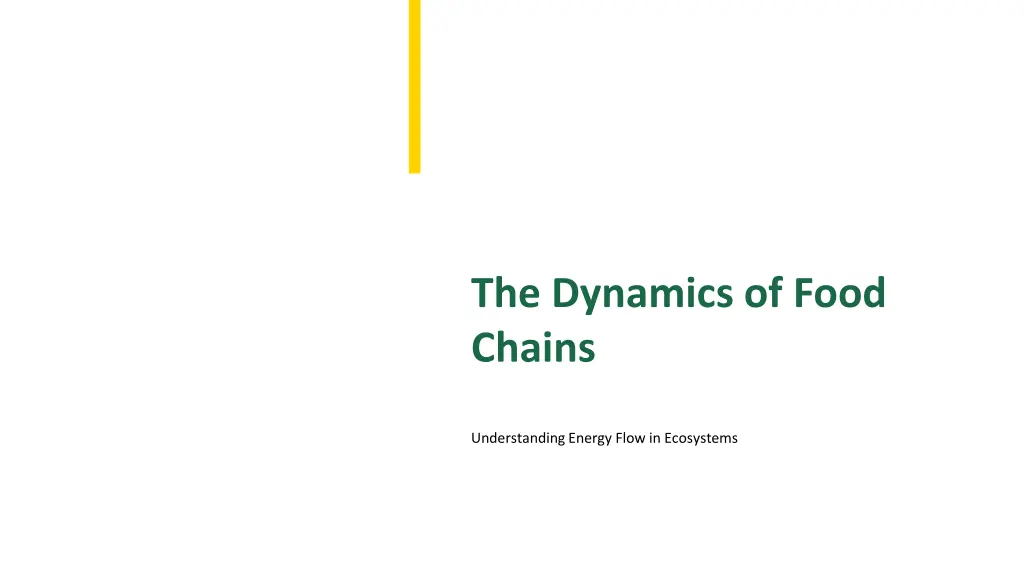
Understanding Energy Flow in Ecosystems: The Dynamics of Food Chains
Explore the intricate dynamics of food chains and energy flow in ecosystems with a focus on trophic levels, producers, consumers, and the vital role they play in sustaining life forms. Discover how energy is transferred through different biotic levels, emphasizing the importance of ecosystem balance. Delve into the essence of food chains and the crucial role they play in nature's energy flow.
Download Presentation

Please find below an Image/Link to download the presentation.
The content on the website is provided AS IS for your information and personal use only. It may not be sold, licensed, or shared on other websites without obtaining consent from the author. If you encounter any issues during the download, it is possible that the publisher has removed the file from their server.
You are allowed to download the files provided on this website for personal or commercial use, subject to the condition that they are used lawfully. All files are the property of their respective owners.
The content on the website is provided AS IS for your information and personal use only. It may not be sold, licensed, or shared on other websites without obtaining consent from the author.
E N D
Presentation Transcript
The Dynamics of Food Chains Understanding Energy Flow in Ecosystems Photo by Pexels
01 The Essence of Food Chains Table of Contents 02 Trophic Levels Explained 03 Producers: The Powerhouses 04 Primary Consumers: The Herbivores 05 Secondary Consumers: The Carnivores 06 Energy Loss in Food Chains 07 Decomposers: Nature's Recyclers 08 Ecosystem Interdependence 09 Conservation of Food Chains 10 Thank You!
1 The Essence of Food Chains Nature's Energy Flow Food chains represent the complex series of organisms feeding on one another, highlighting energy transfer through various biotic levels. Each step in a food chain is known as a trophic level, starting with producers who convert solar energy into food. Understanding food chains helps us realize the intricate connections between differentspecies in ecosystems. Overall, food chains illustrate the flow of energy essential for life. Photo by Pexels
2 Trophic Levels Explained Levels of Life Trophic levels categorize organisms based on their role in energy transfer: producers, primary consumers, secondary consumers, and tertiary consumers. At the first level, autotrophs capture sunlight to create food, while heterotrophs depend on these for energy. This structured hierarchy is crucial for ecosystem balance and energy distribution. Each level plays a vital role in sustaining life forms in nature. Photo by Pexels
3 Producers: The Powerhouses Energy Harvesters Producers, like green plants, harness solar energy, converting it into chemical energy for all living beings. They are the foundation of food chains, providing energy for primary consumers. A staggering 10% of solar energy is converted into food energy, creating a lifeline for ecosystem inhabitants. Without these energy harvester, life as we know it would be impossible. Photo by Pexels
4 Primary Consumers: The Herbivores Nature's Eaters Primary consumers, or herbivores, rely on producers for energy, feeding on plants and converting organic matter into their own energy. This group plays a crucial role, acting as intermediaries between the energy captured by plants and higher trophic levels. These consumers face energy loss as heat, for digestion, and growth, impacting the following levels. They are essential for the continuation of food chains. Photo by Pexels
5 Secondary Consumers: The Carnivores Predators of the Food Chain Secondary consumers are small carnivores that feed on primary consumers, obtaining energy and nutrients from their prey. Their role is vital as they regulate herbivore populations, maintaining ecosystem balance. However, they also face energy losses in the transfer, limiting their numbers in ecosystems. Understanding their role helps us appreciate biodiversity and ecological dynamics. Photo by Pexels
6 Energy Loss in Food Chains The 10% Rule As energy flows up the food chain, substantial losses occur at each trophic level, primarily as heat. On average, only about 10% of the energy from one level is available to the next, leading to fewer organisms at higher levels. This phenomenon illustrates why food chains typically consist of three to four levels, limiting their complexity. Awareness of this principle is key to understanding food web dynamics. Photo by Pexels
7 Decomposers: Nature's Recyclers Closing the Loop Decomposers play a critical role by breaking down dead organic matter, returning nutrients to the soil. This recycling process keeps ecosystems healthy and allows producers to thrive, completing the energycycle. Without decomposers, ecosystems would be overwhelmed by organic waste, disrupting the balance of nature. They are essential for sustaining life and promoting growth in ecosystems. Photo by Pexels
8 Ecosystem Interdependence A Web of Life The interconnectedness of food chains forms complex webs, where each organism influences others' survival. Ecosystems thrive on these relationships, highlighting the importance of biodiversity. Loss of one species can disrupt entire food webs, affecting all trophic levels. Preserving these connections is vital for environmental sustainability. Photo by Pexels
9 Conservation of Food Chains Preserving Balance Understanding food chains aids in the conservation of species and their habitats, essential for ecological balance. Conservation efforts must focus on protecting producers and maintaining biodiversity. Community involvement and awareness can foster sustainable practices that support food chains. Together, we can ensure a balanced ecosystem for future generations. Photo by Pexels
10 Thank You! Questions and Discussion Thank you for exploring the dynamics of food chains with us today! Feel free to ask any questions or share your thoughts on this vital topic. Let's engage in a discussion about the importance of food chains in our world. Your insights are valuable in understanding and preserving our ecosystems. Photo by Pexels
